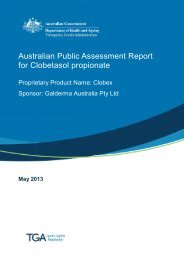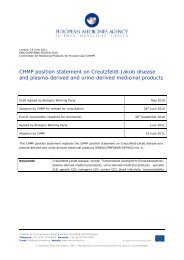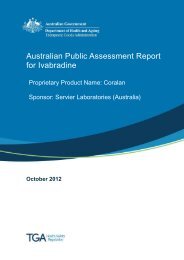Australian public assessment for Ibuprofen - Therapeutic Goods ...
Australian public assessment for Ibuprofen - Therapeutic Goods ...
Australian public assessment for Ibuprofen - Therapeutic Goods ...
You also want an ePaper? Increase the reach of your titles
YUMPU automatically turns print PDFs into web optimized ePapers that Google loves.
AusPAR Caldolor <strong>Ibuprofen</strong> Phebra Pty Ltd PM-2010-02393-3-1<br />
Final 2 January 2013<br />
<strong>Therapeutic</strong> <strong>Goods</strong> Administration<br />
Infusion site pain was reported by 4 (33%) subjects during rapid infusion of Caldolor,<br />
although it was mild in all cases. A more comprehensive <strong>assessment</strong> of infusion pain, <strong>for</strong><br />
example, using a visual analogue score (VAS), was not conducted and would not have been<br />
meaningful in the absence of placebo control.<br />
Systemic exposure to ibuprofen after an 800 mg dose of Caldolor, when infused over 5-7<br />
minutes, was equivalent to exposure after a single US-marketed 800 mg tablet,<br />
administered orally. The tmax of ibuprofen was much shorter after rapid IV administration<br />
than after oral dosing or IV administration over 30 minutes (in CPI-CL-004) or 1 h (in CPI-<br />
CL-001). This reduced tmax would probably translate into a faster onset of analgesia after<br />
the first dose, and after subsequent doses if they are not given until pain recurs. This<br />
would be clinically useful in a postoperative or other acute pain setting.<br />
However, the Cmax of ibuprofen after rapid IV infusion was approximately doubled<br />
compared to oral administration of the same dose. As noted in the sponsor’s Clinical<br />
Overview, the clinical implication of these higher peak concentrations is not known.<br />
Although there was no evidence of systemic toxicity in this small study, the potential <strong>for</strong><br />
an adverse effect of high peak concentrations in a patient population cannot be excluded.<br />
The main clinical studies used a 30 minute infusion which provided reasonably rapid<br />
onset of analgesia with lower peak ibuprofen concentrations (similar to those seen with to<br />
oral dosing - see Table 7, below). In view of this consideration and the paucity of<br />
tolerability data <strong>for</strong> the proposed rapid infusion, approval of the rapid infusion is not<br />
recommended.<br />
Table 7. Mean ibuprofen Cmax (μg/mL) after a single dose of IV Caldolor or US-marketed oral<br />
ibuprofen preparations, according to infusion duration and study population.<br />
Dose<br />
(mg)<br />
Healthy,<br />
60 min<br />
CPI-CL<br />
-001<br />
IV infusion (Caldolor) Oral<br />
Critically<br />
ill, 30 min<br />
CPI-CL<br />
-004<br />
Noncritically<br />
ill,<br />
30 min<br />
CPI-CL<br />
-004<br />
Healthy,<br />
5-7 min<br />
CPI-CL<br />
-011<br />
Healthy Healthy<br />
CPI-CL<br />
-001<br />
100 - 8.2 14.5 - - -<br />
200 19.3 11.5 22.9 - 24.7 -<br />
400 39.2 25.7 49.1 - 42.9 -<br />
CPI-CL<br />
800 72.6 - - 120 81.0 63<br />
Summary of pharmacokinetics<br />
Systemic exposure to ibuprofen after IV administration of Caldolor was equivalent to<br />
systemic exposure after oral administration of a matching dose of US-marketed ibuprofen<br />
capsules and tablets. However, no comparison to an <strong>Australian</strong>-registered ibuprofen<br />
product was submitted.<br />
<strong>Ibuprofen</strong> Cmax and AUC were less than proportional to the dose after administration of IV<br />
and oral ibuprofen.<br />
-011<br />
When Caldolor was infused over a period of 30 to 60 minutes, peak ibuprofen<br />
concentrations were roughly comparable to those seen when the same dose was given<br />
orally, although this is based on cross-study comparisons to US-marketed oral products.<br />
Page 20 of 118
















